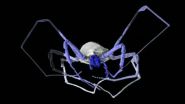(Press-News.org) Working with human neurons and fruit flies, researchers at Johns Hopkins have identified and then shut down a biological process that appears to trigger a particular form of Parkinson's disease present in a large number of patients. A report on the study, in the April 10 issue of the journal Cell, could lead to new treatments for this disorder.
"Drugs such as L-dopa can, for a time, manage symptoms of Parkinson's disease, but as the disease worsens, tremors give way to immobility and, in some cases, to dementia. Even with good treatment, the disease marches on," says Ted Dawson, M.D., Ph.D., professor of neurology and director of the Johns Hopkins Institute for Cell Engineering,
Dawson says the new research builds on a growing body of knowledge about the origins of Parkinson's disease, whose symptoms appear when dopamine-producing nerve cells in the brain degenerate. Further evidence for a role of genetics in Parkinson's disease appeared a decade ago when researchers identified key mutations in an enzyme known as leucine-rich repeat kinase 2, or LRRK2 — pronounced "lark2." When that enzyme was cloned, Dawson, together with his wife and longtime collaborator Valina Dawson, Ph.D., professor of neurology and member of the Institute for Cell Engineering, discovered that LRRK2 was a kinase, a type of enzyme that transfers phosphate groups to proteins and turns proteins on or off to change their activity.
Over the years, it was found that blocking kinase activity in mutated LRRK2 halted degeneration, while enhancing it made things worse. But nobody knew what proteins LRRK2 was acting on.
"For nearly a decade, scientists have been trying to figure out how mutations in LRRK2 cause Parkinson's disease," said Margaret Sutherland, Ph.D., a program director at the National Institute of Neurological Disorders and Stroke. "This study represents a clear link between LRRK2 and a pathogenic mechanism linked to Parkinson's disease."
Dawson went fishing for the right proteins using LRRK2 as bait. When his team began to identify those proteins, Dawson says they were surprised to discover that many were linked to the cellular machinery, like ribosomes, that make proteins. Nobody, says Dawson, suspected that LRRK2 might be involved at such a basic level as protein manufacture.
Unsure if they were right, the team then tested the proteins they identified to see which of them, if any, LRRK2 could add phosphate groups to. They came up with three ribosomal protein candidates — s11, s15 and s27. They then altered each ribosomal protein to see what would happen. It turned out that mutating s15 in a manner that blocked LRRK2 phosphorylation protected nerve cells taken from rats, humans and fruit flies from death. In other words, s15 appeared to be the much sought-after target of LRRK2, Dawson says.
"When you go fishing, you want to catch fish. We just happened to catch a big one," Dawson says.
With the protein now identified, Dawson's team is tackling further experiments to find out how excess protein production causes dopamine neurons to degenerate. And they want to see what happens when they block LRRK2 from phosphorylating the s15 protein in mice, to build on their findings from fruit flies and nerve cells grown in a dish.
"There's a big chasm between animal disease models and human treatments," says Ian Martin, Ph.D., a neuroscientist in Dawson's lab and the lead author on the paper. "But it's exciting. I think it definitely could turn into something real, hopefully in my lifetime."
INFORMATION:
Other authors on the paper include Jungwoo Wren Kim, Byoung Dae Lee, Hochul Kang, Jin-Chong Xu, Hao Jia, Jeannette Stankowski, Min-Sik Kim, Jun Zhong,
Manoj Kumar, Shaida Andrabi, Yulan Xiong, Dennis Dickson and Akhilesh Pandey from the Johns Hopkins University School of Medicine and Zbigniew Wszolek of the Mayo Clinic.
The Johns Hopkins University is part of the Morris K. Udall Centers of Excellence for Parkinson's Disease. This work was supported by the National Institute of Neurological Disorders and Stroke (P50 NS038377 and P50 NS072187), the JPB Foundation, the Maryland Stem Cell Research Fund, the Adrienne Helis Malvin Medical Research Foundation and the Diana Helis Henry Medical Research Foundation.
Funding for a portion of the research described in this article was provided by Merck KGAA. Under a licensing agreement between Merck KGAA and The Johns Hopkins University, Dawson and the university shared fees received by the university on licensing of some of the reagents described in this article. Dawson was also a paid consultant to Merck KGAA. The terms of this arrangement are being managed by The Johns Hopkins University in accordance with its conflict of interest policies. END
Getting to the root of Parkinson's disease
2014-04-10
ELSE PRESS RELEASES FROM THIS DATE:
Too much protein may kill brain cells as Parkinson's progresses
2014-04-10
Scientists may have discovered how the most common genetic cause of Parkinson's disease destroys brain cells and devastates many patients worldwide. The study was partially funded by the National Institutes of Health's National Institute of Neurological Disorders and Stroke (NINDS); the results may help scientists develop new therapies.
"This may be a major discovery for Parkinson's disease patients," said Ted Dawson, M.D., Ph.D., director of the Johns Hopkins University (JHU) Morris K. Udall Center of Excellence for Parkinson's Disease, Baltimore, MD. Dr. Dawson and ...
Researchers determine how mechanical forces affect T-cell recognition and signaling
2014-04-10
T-cells are the body's sentinels, patrolling every corner of the body in search of foreign threats such as bacteria and viruses. Receptor molecules on the T-cells identify invaders by recognizing their specific antigens, helping the T-cells discriminate attackers from the body's own cells. When they recognize a threat, the T-cells signal other parts of the immune system to confront the invader.
These T-cells use a complex process to recognize the foreign pathogens and diseased cells. In a paper published this week in the journal Cell, researchers add a new level of understanding ...
Researchers identify transcription factors distinguishing glioblastoma stem cells
2014-04-10
The activity of four transcription factors – proteins that regulate the expression of other genes – appears to distinguish the small proportion of glioblastoma cells responsible for the aggressiveness and treatment resistance of the deadly brain tumor. The findings by a team of Massachusetts General Hospital (MGH) investigators, which will be published in the April 24 issue of Cell and are receiving advance online release, support the importance of epigenetics – processes controlling whether or not genes are expressed – in cancer pathology and identify molecular circuits ...
Yale researchers search for earliest roots of psychiatric disorders
2014-04-10
Newborns whose mothers were exposed during pregnancy to any one of a variety of environmental stressors — such as trauma, illness, and alcohol or drug abuse — become susceptible to various psychiatric disorders that frequently arise later in life. However, it has been unclear how these stressors affect the cells of the developing brain prenatally and give rise to conditions such as schizophrenia, post-traumatic stress disorder, and some forms of autism and bipolar disorders.
Now, Yale University researchers have identified a single molecular mechanism in the developing ...
Some birds come first -- a new approach to species conservation
2014-04-10
New Haven, Conn.— A Yale-led research team has developed a new approach to species conservation that prioritizes genetic and geographic rarity and applied it to all 9,993 known bird species.
"To date, conservation has emphasized the number of species, treating all species as equal," said Walter Jetz, the Yale evolutionary biologist who is lead author of a paper published April 10 in Current Biology. "But not all species are equal in their genetic or geographic rarity. We provide a framework for how such species information could be used for prioritizing conservation."
Worldwide, ...
Penn study finds mechanism that regulates lung function in disease Birt-Hogg-Dube syndrome
2014-04-10
(PHILADELPHIA) – Researchers at Penn Medicine have discovered that the tumor suppressor gene folliculin (FLCN) is essential to normal lung function in patients with the rare disease Birt-Hogg-Dube (BHD) syndrome, a genetic disorder that affects the lungs, skin and kidneys. Folliculin's absence or mutated state has a cascading effect that leads to deteriorated lung integrity and an impairment of lung function, as reported in their findings in the current issue of Cell Reports.
"We discovered that without normal FLCN the alveolar epithelial cells (AEC) in these patients' ...
Ancient 'spider' images reveal eye-opening secrets
2014-04-10
VIDEO:
This is a video showing the 305-million-year-old harvestman fossil.
Click here for more information.
Stunning images of a 305-million-year-old harvestman fossil reveal ancestors of the modern-day arachnids had two sets of eyes rather than one.
The researchers say their findings, published in the journal Current Biology, add significant detail to the evolutionary story of this diverse and highly successful group of arthropods, which are found on every continent except Antarctica.
University ...
Poor mimics can succeed as long as they mimic the right trait
2014-04-10
There are both perfect and imperfect mimics in nature. An imperfect mimic might have a different body shape, size or colour pattern arrangement compared to the species it mimics.
Researchers have long been puzzled by the way poor mimicry can still be effective in fooling predators not to attack. In the journal Current Biology, researchers from Stockholm University now present a novel solution to the question of imperfect mimicry.
Mimicry is when animals have the appearance of another species in order to avoid being attacked. For instance, hoverflies have a similar ...
Enzyme 'wrench' could be key to stronger, more effective antibiotics
2014-04-10
Builders and factory workers know that getting a job done right requires precision and specialized tools. The same is true when you're building antibiotic compounds at the molecular level. New findings from North Carolina State University may turn an enzyme that acts as a specialized "wrench" in antibiotic assembly into a set of wrenches that will allow for greater customization. By modifying this enzyme, scientists hope to be able to design and synthesize stronger, more adaptable antibiotics from less expensive, natural compounds.
Kirromycin is a commonly known antibiotic ...
NEJM: High-risk seniors surgery decisions should be patient-centered, & physician led
2014-04-10
Surgery for frail, senior citizen patients can be risky. A new patient-centered, team-based approach to deciding whether these high-risk patients will benefit from surgery is championed in an April 10 Perspective of the New England Journal of Medicine. The Perspective suggests that the decision to have surgery must balance the advantages and disadvantages of surgical and non-surgical treatment as well as the patient's values and goals in a team-based setting that includes the patient, his or her family, the surgeon, the primary care physician and the physician anesthesiologist.
One ...


